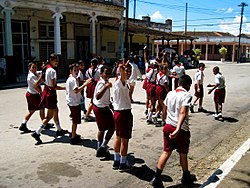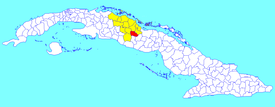Placetas
| Placetas | |
|---|---|
| Municipality | |

OPJM pioneers in town center
|
|
| Nickname(s): La Villa de los Laureles (Laurel City) | |
 Placetas municipality (red) within Villa Clara Province (yellow) and Cuba |
|
| Location of Placetas in Cuba | |
| Coordinates: 22°18′57″N 79°39′20″W / 22.31583°N 79.65556°WCoordinates: 22°18′57″N 79°39′20″W / 22.31583°N 79.65556°W | |
| Country |
|
| Province | Villa Clara |
| Established | 1861 |
| Incorporated | 1881 (town) |
| 1925 (city) | |
| Area | |
| • Total | 601 km2 (232 sq mi) |
| Elevation | 205 m (673 ft) |
| Population (2004) | |
| • Total | 71,208 |
| • Density | 119.5/km2 (310/sq mi) |
| Time zone | EST (UTC-5) |
| Area code(s) | +53-428 |
| Highways | Carretera Central |
Placetas (Spanish pronunciation: [plaˈsetas]) is a city in the Villa Clara Province in the center of Cuba; before the change in the country's government in 1959 the province was called Las Villas. The town is also known as La Villa de los Laureles because of its wild laurel trees. Placetas is also a municipio, one of 13 subdivisions of the Villa Clara Province. Cuba's geographical center, Guaracabulla, is located in this municipality.
Placetas was founded on September 9, 1861 mainly due to the sugar production industry. Nowadays, the main produce of the area is tobacco. The main contribution to its foundation came from Jose Martinez-Fortun y Erles, a Spanish Marques and former colonel in the Spanish Army. The town is located on the Carretera Central road, which cuts through the town. The town's position on this road has allowed it to serve as a stop for many travellers. Placetas has grown considerably over the years, being declared a town in 1881 and a city in 1925. In 1879 it was established as its own municipality. Placetas is also known by the great carnavals which take place in July and Christmas and New Year's Eve.
Close towns include Zulueta (to the north), Remedios (to the northeast), Cabaiguán and Fomento (to the east), and Santa Clara and Camajuaní (to the west).
In common with other Cuban towns, the city of Placetas was originally divided in barrios. These were: Cabecera, Guaracabulla (or Guaracabuya), Hernando, Nazareno, San Andres Sitio Potrero and Tibisial. Annual celebrations displaying the local pride of each barrio used to take place until the 1990s, when the government stopped them.
...
Wikipedia

